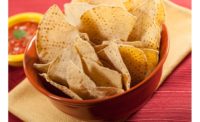When a gluten-free version of Sheila G’s Brownie Brittle hit U.S. stores in 2017, JoAnn Rupp, global market insights manager, Corbion, Lenexa, KS, noticed something that distinguished the product on an increasingly crowded gluten-free shelf.
“Messaging on the package minimized its gluten-free claims and instead focused on taste and flavor,” recalls Rupp. Indeed, as she learned, Mintel research found that 72 percent of consumers would likely or definitely buy the treat—outpacing performance in the cookies category overall.
And for Rupp, that signaled a significant mainstreaming of gluten-free foods, not to mention a powerful lesson for gluten-free snack and bakery brands: “This product tapped into an established trend—convenience—and an emerging one, too: taste-focused messaging. The result is that the item gained wider appeal than it could have if the manufacturer had focused primarily on its gluten-free identity. It’s an important reminder for snack producers and bakers looking to craft healthier treats: Taste is still king.”
And with ingredients continually improving, royal taste can reign—even in gluten-free snack and bakery.
Small sliver
According to “Celiac Disease: Facts and Figures” from the University of Chicago Celiac Disease Center, celiac disease affects only 1 percent of healthy Americans, translating into about 3 million people living with the condition. Further, a 2017 study published in the World Journal of Gastroenterology found that a mere 6 percent of the domestic population experiences non-celiac gluten sensitivity (“Non-celiac gluten sensitivity: All wheat attack is not celiac”).
Yet according to a March 2019 report from Grand View Research, the gluten-free market hit $17.6 billion in 2019 and should grow at a healthy CAGR of 9.1 percent from 2019 to 2025.
How can such a small sliver of consumers generate such robust gluten-free demand? The answer is that they can’t—at least not all on their own.
Gluten-free for all
Such gluten-free growth wouldn’t make sense if the only consumers fueling it were those who had to. But recent years have seen the audience for gluten-free products expand well beyond consumers with medical motives for patronizing the category.
Notes Pam Stauffer, global marketing programs manager, Cargill, Minneapolis, “In the last decade, the market for gluten-free products has expanded rapidly.” She points to evidence from HealthFocus International’s “2019 USA Trend Study” that fully 29 percent of consumers rate gluten-free labels extremely or very important, up 14 percent from 2014.
How this happened is a topic of keen interest. As Ricardo Rodriguez, marketing manager, confectionery and bakery, Ingredion Incorporated, Westchester, IL, explains, while the gluten-free market rests on a base of about 23 million Americans who must avoid gluten for diagnosed reasons, “the sales ‘moving the needle,’” he says, “come from consumers who’re part of the ‘free-from’ movement and purchase gluten-free because of the surrounding healthy halo. In the U.S., there are anywhere from 61 to 100 million of these consumers—and growing.”
That healthy halo is a powerful motivator. According to the 2019 HealthFocus study, 20 percent of consumers view gluten-free foods and drinks as “a lot healthier.”
“Consumers also often feel they’re getting additional potential benefits from gluten-free,” Rodriguez continues, “including a shorter ingredient label, a more ‘natural’ product, assistance with weight loss and reduction in inflammation—even when the product doesn’t specify these claims.”
Gluten-free eating also parallels the adoption of “lifestyle” diets. As Rupp notes, consumers don’t choose gluten-free just for its healthy reputation; “it also meets the qualifications of diets like keto and Paleo.”
Sometimes going gluten-free is the simplest way to feed friends and family.
Innova Market Insights found that in families and social situations, consumers without gluten sensitivities often find it easier to serve one gluten-free item for all rather than a selection of products that fit gluten-friendly and gluten-averse diets, Rupp says.
Research from Chicago’s Mintel affirms those observations. “Family-friendly brands with multiple certifications can reach numerous niche audiences with a single product line, especially in households where everyone wants to enjoy the same foods, even if only one member has a dietary restriction,” says Karen Formanski, health and nutrition analyst.
Mintel’s “Free-from Foods—U.S.” June 2019 report found that 11 percent of consumers either avoid wheat or gluten or live with someone who does. “Parents of children under 18 are seeking allergy-friendly products,” says Formanski, “which may indicate that even if their own children don’t suffer allergies, they’re shopping for items safe to bring in school lunches or for visitors with allergies.”
Setting sights on snacks
More often than not, those items are gluten-free baked goods and snacks.
IRI data through the 52 weeks ending December 29, 2019, show that snacks are “by far the largest subcategory within the gluten-free space,” Rodriguez says, “reaching $3.0 billion in sales in 2019, which represented 9 percent growth versus 2018.”
Although not as strong sales-wise, baked goods saw the largest year-to-date percentage growth, in IRI’s analysis, at 73 percent. The upshot, says Rodriguez: “The snack and baked-good categories contribute a great deal and are very important to growth in the gluten-free market.”
This makes sense to Michael Smulders, founder and president, Bakery on Main, East Hartford, CT. But while both categories keep trending upward, he wagers that snacks have more growing room “because of consumers’ increasingly busy lifestyles and the trend to substitute snacking for full meals.”
Matt Gennrich, food scientist, Cargill, says: “In some respects, snacks lend themselves more to gluten-free formulation, as the combined formulating and processing difficulties aren’t as great as we encounter in traditional bakery. Crackers, pretzels, chips, energy bars—all of these already have examples of retail offerings in gluten-free form, many with widespread consumer acceptance.”
Either way, says Rupp, “With such a large chunk of launches coming from these two categories, manufacturers have an opportunity to innovate in the gluten-free space to create products that consumers want.”
Smart strategies
Rupp points out that in gluten-free baking, enzymes solve several common manufacturing problems. “If a product has a tough texture, enzymes can modify the dough structure to help attain necessary softness.” Enzymes also improve process feasibility and address shelf-life issues.
Meanwhile, leavening agents and fibers improve texture in excessively dense dough, binding agents like proteins and xanthan gum prevent unwanted crumbliness and egg proteins and starches can adjust dough viscosity so as to prevent hole formation in the crumb structure, says Rupp.
Gennrich believes that more than new ingredients, a wiser use of existing ones accounts for quality improvements in the space. “In the early days, many gluten-free products used single starches as substitutes for wheat flour, and there was a heavy reliance on a few specific gums for texture control. Fast-forward to today and we’ve learned that taste and texture usually improve by combining two or more starches, especially if any have distinct flavor profiles. Likewise, while a single starch may have a neutral, pleasing flavor, it may not provide the desired finished texture alone.”
Thus, starch blends—often in conjunction with flours, gums, pre-gel starches, enzymes and more—have become heroes in gluten-free snack and bakery formulation. As Gennrich says, “We’ve come a long way in understanding how to use ingredient blends better to address flavor and texture.”
Whole-food ingredients
With more consumers looking suspiciously at lengthy ingredient statements, however, gluten-free manufacturers are eager to do more with less. And they’re eager to find “clean,” “whole-food” ingredients with which to do it.
“As in every other grocery space, we see customers trying to ‘clean up’ their gluten-free offerings,” Gennrich says. If refined flours and modified starches once passed unnoticed, “bakers today are reformulating their gluten-free recipes to use ingredients that are more familiar to consumers.”
One such ingredient is oats, which aren’t just familiar and gluten-free, but “have the added benefit of being recognized as a superfood,” Rupp says. With a balanced nutritional profile comprising healthy fats, iron, calcium, vitamin E, magnesium, vitamin B1 and folic acid, oats are natural emulsifiers in breads, pasta, crackers and biscuits, she continues, “helping them achieve a softer texture and nuttier taste.”
Braden Bennie, senior marketing manager, TH Foods, Inc., Henderson, NV, is bullish on cassava flour, which he says is often referred to as “the ‘holy grail’ of gluten- and grain-free cooking.” A staple crop in parts of South America, Asia and Africa, it’s gaining momentum in gluten-free formulations thanks to its functional properties.
Bennie considers cassava flour fundamental to his company’s Crunchmaster line of grain- and gluten-free snacks. “When we had the idea of offering consumers a grain-free option,” he recalls, “we knew we couldn’t compromise our signature satisfying crunch. So we needed a grain-free solution that could deliver the crunch that consumers came to know, love and expect from our snacks.” Enter cassava.
Laura Gerhard, director of strategy and marketing, Blue Diamond Almonds Global Ingredients Division, Sacramento, CA, sees opportunities for almond flour in gluten-free applications—in no small part thanks to its health attributes, since it has the same nutritional credentials as whole almonds.
From a processing standpoint, Gerhard claims that almond flour’s smooth texture and fine granulation contrast with the rough grittiness that plagues other gluten-free flours. “The ingredient is perfect for baking and can be used in an array of applications, including gluten-free cakes, breads and muffins, as well as cookies, bars and crackers.”
Gluten-free snacks are also “a big play” for sorghum flour, observes Doug Bice, market development director, Sorghum Checkoff, Lubbock, TX. “Lines such as KaPops, Right Rice, RTE Cuisine and numerous popped sorghum suppliers are making inroads in the consumer food market.”
Bice predicts that future sorghum use in gluten-free snacks and baking will rest on two key drivers. First: high-antioxidant sourcing. “There are now a number of sorghum varietals identified with high ORAC values that can be incorporated into such markets.” Second, novel “waxy” sorghum hybrids have “unique starch ratios” that he says provide cost-effective processing benefits in extruded puffs, pillows, kibbles and other snack forms.
Pulse of the nation
“Manufacturers are definitely creating innovative new products using plant-based ingredients that are gluten-free,” says Joni Huffman, senior vice president, sales and marketing, Healthy Food Ingredients, Fargo, ND. And while some options are grain-, root- or tuber-based, “recently pulse utilization has been driving growth.”
Mike Hallman, vice president of sales, Firebird Artisan Mills, Harvey, ND, agrees. “Pulses such as garbanzo, lentil and various bean varieties incorporate the appeal of gluten-free, allergen-friendly, non-GMO and even organic in a clean, healthy snack.” His company recently commercialized a roasted garbanzo flour with a cleaner, more neutral taste for use in baked products and snacks.
Rodriguez noted that his company’s line of pulse flours supplies gluten-free fiber and protein sourced from non-GMO yellow peas, yellow lentils, faba beans, red lentils and chickpeas. “Breads, tortillas, pizza, cookies, cakes, crackers and muffins are some of the baked goods that they’re good candidates for,” he suggests.
And Paul Laubscher, director of marketing, Calbee North America, Fairfield, CA, points out that green peas, black beans and red lentils always lead his company’s Harvest Snaps formulations, helping the snacks deliver 4 to 5 grams of plant protein, 3 to 5 grams of fiber and calcium and potassium in each serving, while leaving the products “completely free of artificial flavors, colors and the common allergens soy, nuts, wheat and eggs”—and, of course, gluten.
This focus on nutritional benefits beyond the gluten’s absence is another sign of the category’s maturation. Many legacy products used sugar, fat and refined ingredients to make up for the missing gluten. But as healthful, wholesome gluten-free ingredients have hit the scene, “Advancing the functional nutrition of gluten-free products has become an area of opportunity,” Rodriguez says. “Gluten-free consumers now look beyond just texture and taste; they want improved nutrition, too.”
And while “whole-food” ingredients impress gluten-free fans with their fresh-from-the-farm image, Hallman was quick to note that these ingredients are by no mean old-fashioned. “New forms have evolved into flaked, extruded, pre-gel and roasted products that provide functionality, alternative textures and improved taste along with gluten-free nutrition,” he says.
Moon shots
That’s given category insiders cause for optimism.
For example, packaging advances are keeping Danielle Benjamin, brand manager, Canyon Bakehouse, Johnstown, CO, excited. Calling such advances “the game changer,” she recalled a time when gluten-free baked goods were exiled to the cold case. But thanks to the shelf stability that comes with modified-atmosphere packaging, “Products once confined to freezers can now be sold and stored at room temperature in the bakery aisle.” And that’s without reformulation or quality loss. “Being able to break out of the traditional gluten-free space has been a great opportunity and benefit to both brands and consumers.”
Nevertheless, costs associated with gluten-free sourcing, reformulation and processing still trickle down to retail prices, putting some gluten-free snacks and baked goods out of reach for consumers. “However,” Rupp says, “as technology improves and more products enter the market, we believe bakers will be able to offer more competitive pricing.”
Certain applications also continue to confound product developers. Replicating a traditional cake or muffin texture without gluten, for instance, has been an R&D moon shot. Yet “while bakers may never match a high-ratio wheat-based cake,” Gennrich says, “they can produce a gluten-free version worthy of a celebration” by nailing the right starch ratio. His company studied gelatinization in conventional wheat-containing cakes and matched it in a non-wheat matrix. “We’ve found that blends of label-friendly tapioca and native corn starches help bakers create fine-textured gluten-free cakes and muffins.”
Artisan breads—hand-formed boules; crusty-on-the-outside/chewy-on-the-inside baguettes—also remain on the gluten-free wish list. And though better functional proteins and “ingredient synergies” will move the ball forward, “the solution may well arise from advances in wheat breeding and plant genetics,” Gennrich predicts. “There continues to be progress toward developing wheat varietals that don’t promote the autoimmune response associated with celiac disease—so this’ll be an interesting space to watch.”
Regardless, says Rupp, “One of the toughest things manufacturers will contend with in the gluten-free space is consumer expectations around appearance and taste.” That being the case, “It’s extremely important that manufacturers successfully deliver high-quality, great-tasting gluten-free products if they want to gain traction with consumers.”








